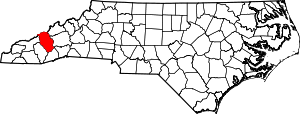






Please add profiles for those who were born, lived or died in Haywood County, North Carolina.
Haywood county was officially separated from Buncombe County through a bill introduced by General Thomas Love that became law on Dec 23 1808. The new county of Haywood became official in Mar 1808. By the time Haywood county was separated from Buncombe, more than 300 families were living in the territory between Buncombe county and the Tennessee line. Many of these families came to the area because their ancestors were part of the march of General Griffith Rutherford and his 2,400 troops against the Cherokee during the American revolution. These soldiers were introduced to the beauty of the oldest mountain range (Appalachians) on the planet. Many of them returned to settle the region after the war was over.
At the end of the Revolution the boundary line of the Cherokee Territory was along the Blue Ridge. In 1783, a Treaty placed the boundary along the Pigeon River, opening that area to settlement. Meanwhile, Congress agreed that soldiers and officers who had served to the end of the war would receive land. Those granted land began to arrive in 1785. In 1796, a land grant to David Allison for 250, 240 acres included much of what is now Haywood County. Both Thomas Love and his brother Robert began amassing their own land fortunes in this region and west into Tennessee.
On Mar 27, 1809, at least 12 Justices of the Peace, many who served when the area was still part of Buncombe County, gathered and conducted the first election of county officials. Robert Love was elected Clerk of Court and William Allen became Sheriff, In the bill introduced by Thos. Love, a group of seven men had been named to choose a place near the center of the county to erect public buildings. However, It was the offer of 17 acres of property by Robert Love that eventually dictated where the county center would be- the hill along which Waynesvilles Main St runs today. The county was named in honor of John Haywood, the State treasurer, who ironically never lived in or visited the region.
The last shot of the Civil War east of the Mississippi was fired in Waynesville on May 9, 1865, when elements of the Thomas Legion (Confederate) skirmished with the 2nd NC Mounted (Union). A monument is situated on Sulphur Springs Road in Waynesville.
Adjacent Counties
Canton
Canton has a population of about 4,200 people and is located along the Pigeon River in the eastern part of the county. Incorporated in 1837, Canton is home to a historic paper mill and the historic Colonial Theater. Haywood County’s oldest church, now First Baptist Church in Canton, was established in 1801 as Locust Old Fields Church.
Clyde
Clyde, a small town of about 1,400 people just west of Canton, is home to Haywood Community College and Haywood Regional Medical Center. Called the “oldest frame house west of the Blue Ridge” by Preservation North Carolina, the Shook Museum at the Shook-Smathers House is located in Clyde and offers tours of this historic structure, circa 1795.
Maggie Valley
Maggie Valley received its name when John Setzer established its first post office in 1904, naming the newly incorporated town after his 14-year-old daughter Maggie. Today, much of Haywood County’s tourism activity originates in Maggie Valley, with such attractions as Wheels Through Time, an all-American transportation museum with a working collection of 250 rare antique motorcycles and automobiles; Ghost Town in the Sky, the newly renovated and reopened wild-west theme park; and Cataloochee Ski Area, the Southeast’s longest operating ski resort.
Waynesville
Waynesville, the county seat and the oldest town in Haywood County, was officially incorporated in 1871. With a population nearing 10,000, Waynesville is the largest town in Western North Carolina west of Asheville. Waynesville has garnered several honors and recognition, including being voted as a “low-cost Eden,” best undiscovered town, best Main Street town, best small town, and best mountain town in the third edition of America’s 100 Best Places to Retire, published by Where to Retire magazine.
Lake Junaluska Assembly
In addition to these four towns, Haywood County also is home to Lake Junaluska Assembly, a camp and conference center for the Southeastern Jurisdiction of the United Methodist Church in the United States, and headquarters of the World Methodist Council, a consultative body that links almost all churches in the Methodist tradition. The 200-acre lake is a popular destination for tourists and local residents, offering everything from a stroll along the lake through an array of roses to a paddle boat trip on the lake. Lake Logan Episcopal Center is a 300-acre retreat center that is available for spiritual retreats, business conferences, seminars and family reunions.
National Register of Historic Places
Pisgah National Forest (part)
Haywood County Historical & Genealogical Society
NC Estate Files - Haywood County
